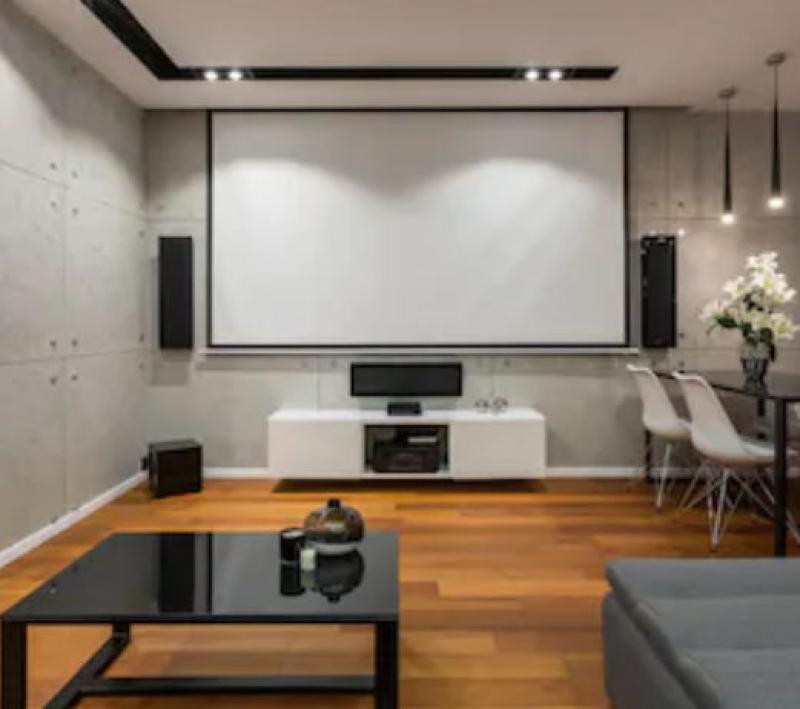To See Your Projector Right, You Gotta Go Dark
by Steffen Ploeger on Sep 30, 2015
Sure, most homeowners would love to have their very own home theatre – and for good reason. Imagine, no more long lines, no more sold out shows, no more sticky floors or uncomfortable seats. Though it’s likely the cost puts this particular luxury a tad on the prohibitive side for many people, for those who have the means to make it a reality, it pays to know how to do it right.
The Home Theatre – Not Exactly An “Out-of-Box” Experience
Sadly, a proper home theatre is not something that’s usually plug-and-play ready. True, projectors have come a long way in terms of being more user-friendly and, generally speaking, offer a pretty intuitive installation. That being said, there is a lot to do before you can turn the lights low, put your feet up, and allow the movie magic wash over you like a bucket of ice-cold water poured from a second-floor window.
Before You Even Decide On Your System
If you plan to just head on down to your local BestBuy and pickup up the unit that happens to be on sale, chances are you’ll be making a return trip – but not before testing your tolerance for dealing with frustration. For this reason, we’ve put together a quick and dirty guide to making the most out of your home entertainment room.
Remember, “Lights” Comes First
Take a look at the room that is destined to become your home theatre. Is it below ground, or on the top floor of your house? Are there large windows or none at all? Depending on how you answered those questions can change what you’ll need to get your room home theatre ready, and it all starts with the room’s lighting.
While projectors themselves are designed to perform under a variety of lighting conditions, if you don’t have the proper window coverings to block out the light, you might as well grab a romance novel and curl up with an afghan, ‘cause the Die Hard marathon just isn’t going to happen. Blackout shades prevent all but the minutest amount of light from entering the room – eliminating glare and enhancing the overall movie experience. As a rule, you’ll likely want cellular shades made from an opaque material.
Examine the Projector’s Specs
We understand that most of the documentation that accompanies an electronic device will invariably go unread – but if there was ever a time to curb this practice, it’s when deciding on which projector you’ll be using. Arguably one of the most important specs you’ll want to pay attention to is the projector’s throw distance/ratio; this critically important piece of info will help you understand which projector will be the right one for your space.
Throw distance is essential in helping you figure out what size of a projection screen you’ll need and how far the projector can be from it. While you may originally have desired to nestle your projector on a shelf along the back wall of the room, depending on the size of the room and the limitations of the projector you may be required to install the projector to a ceiling mount instead – so knowing the projector’s throw distance and ratio is key to knowing which projector will be able to accommodate your desired placement.
Other specs to consider:
-
Lumens; the higher, the better. A high lumen rating offers a greater ability to deal with ambient light levels
-
Contrast. Aim for a contrast ratio of at least 2,000:1
-
Be sure to note whether or not the unit in question has a constant aperture zoom lens (provides improved video quality even if the projector must be moved back from the optimal position)
Cabling: Keep It Organized
If there is one thing that will detract from the overall look and feel of your home theatre, it’s a jumble of wayward and unkempt cords and cables. Power, video, and networking cables can quickly get out of hand so be sure you have a plan to conceal them before deciding on final placement. Depending on where you choose, your cable management system might only consist of a handful of zip ties or a bit of Velcro – in highly visible areas however you might want to consider the use of a small utility cupboard to keep them out of view.
Get to Know The Projector’s Features
This is particularly useful to do before putting the ladder away. After a preliminary installation, give the projector a test drive and make sure you’re comfortable with all the features. Test the range of the remote control (in particularly large areas) so you know how far away you can be from it.
Use a Level Because Eyeballing Just Doesn’t Work
Finally, this last tip might go without saying, but use a level to make sure your projector is sitting on an even plane. There is no sense in investing the kind of time and money necessary to integrate a state of the art entertainment system into your home, only to have a crooked display. Many projectors have adjustable feet so you can adjust while the level sits atop it. Follow these simple rules and you’ll be watching your favorite silver screen classics in no time.
Popular Articles
Three Places to Spend Money on the Exterior of Your Home
When you have the exterior of your home remodeled, you are investing, time, energy and convenience into the project and you want to make sure that...
95860 Views
Homemade Headboards-Make an Upholstered or Wooden Headboard
Homemade headboards can add a lot of personality to any bedroom. They can be coordinated with existing furniture and room decor or they can be the...
74465 Views
When to Use a Brush, Roller or Sponge Brush
Brushes are a good choice for painting trim and woodwork. They are also useful for cutting in the edges around the top and bottom edges and corners...
71826 Views
Creating a Cottage Kitchen with Bead Board
Kitchen decor can range from modern and bold to elegant and elaborate by using strategic kitchen pieces. One of the most popular decorating trends...
52910 Views
Gas Fireplace Diagnostics and Troubleshooting
Follow these steps for diagnosing and troubleshooting Gas Fireplaces repairs. For the average DIYer, this may seem intimidating, depending on the...
30646 Views
Latest Articles
How Much Does It Cost To Take A Bath?
Plumbers know that a bath may seem like a relaxing luxury, but the real cost extends far beyond your water bill. The average soak uses 35 to 50...
on Apr 8, 2025
10 Concrete Patio Ideas on a Budget
A concrete patio can be a game-changer for your outdoor space. It is durable, versatile, and can be customized to fit your style. But what if you...
on Mar 25, 2025
Tips for Creating a Stunning Personalized Photo on Canvas
Order the unique beauty of a personalized photo on canvas and bring your memories to life. With a customized photo on canvas, you can transform...
on Mar 7, 2025
Best Areas to Buy Property in Singapore for Long-Term Growth
Singapore's real estate market remains one of the most stable and lucrative in the world. With limited land supply, strong governmental...
on Feb 18, 2025
Troubleshooting Excess Water in Your HVAC Secondary Condensate Drain Pan
When maintaining your air conditioning system, it is easy to overlook the condensate drain pan - until excess water starts pooling in places where...
on Jan 12, 2025
Featured Articles
What Type of Licensed Contractor Should You Hire?
on Feb 28, 2017
Hire Contractors / Estimates

Looking for a specialty project? There are many types of contractors available for your home improvement needs. Finding the right type of...
Sponsored Articles
Best Areas to Buy Property in Singapore for Long-Term Growth
on Feb 18, 2025
Real Estate / Finance

Singapore's real estate market remains one of the most stable and lucrative in the world. With limited land supply, strong governmental...
Actions
Top Categories
- Garden / Landscaping / Patio — 264
- Kitchen / Bathrooms — 240
- Real Estate / Finance — 203
- Appliance / Repair — 186
- Interior Design / Decor — 184
- HVAC / Air Conditioning — 148
- Cleaning / Maintenance — 144
- Improvements / Remodeling — 131
- Plumbing / Basements — 118
- Floors / Tile / Hardwood — 116
- Doors / Garages — 113
- Safety / Security — 113
Articles Archive
More DIY Articles
Get Your Home Regular Maintenance
When you made this house in your youth, it was like a dream come true for you and your better half. You two took the best care to design even a...
The Appeal and Longevity of Natural Oil Finishes for Hardwood Floors
Hardwood floors exude warmth, character, and timeless appeal in any home. To preserve and enhance these qualities, choosing the right finish is...
How Do I Use Natural Cleaning Products?
One of the real beauties of natural cleaning products is that most of them can be used to clean more than one thing. No more cluttering up your...
7 Reasons Why You Need to Change your Mattress
The role of a mattress in allowing you a quiet, peaceful and comfortable sleep cannot be undermined. In fact, mattresses are a piece of your home...
Simple Tips to Maintain Your Floors’ Beauty in a Busy Home
Floors are not just what you walk on. They are as unique to each room as the room itself. One would not choose the same floors for the bathroom,...

